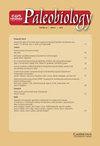已灭绝鸟类腿骨的血流速度表明其粗略运动水平很高
IF 2.7
2区 地球科学
Q2 BIODIVERSITY CONSERVATION
引用次数: 1
摘要
骨孔开始提供更多关于现存和灭绝物种的代谢率和活动水平的信息。本研究调查了可追溯到晚白垩纪的游禽的股骨估计血流量与体重之间的关系。将化石有孔虫的数据与现存物种的数据进行了比较,揭示了所有游禽的相似尺度关系,并支持冠鸟样的陆地运动活动。由于鸟类长骨的灌注率与运动过程中施加的应力引起的微骨折修复的代谢成本有关,因此本研究根据位于股骨轴上的营养孔的大小估算绝对血流量。在考虑了体重和运动行为的差异后,灭绝物种的股骨骨血流量率与现存的游禽相似。水生不会飞的鸟类的股骨健壮性通常比陆生不会飞的鸟类和地面栖息的会飞的鸟类更强,这表明形态是由生活史需求形成的。股骨稳健性在大型游禽类群中也有所增加,这可能与它们在进化中失去尾巴后的体重重新分配有关,据称尾巴限制了股骨长度,使其更水平,因此需要在大型物种中增加稳健性。本文章由计算机程序翻译,如有差异,请以英文原文为准。
Blood flow rates to leg bones of extinct birds indicate high levels of cursorial locomotion
Abstract Foramina of bones are beginning to yield more information about metabolic rates and activity levels of living and extinct species. This study investigates the relationship between estimated blood flow rate to the femur and body mass among cursorial birds extending back to the Late Cretaceous. Data from fossil foramina are compared with those of extant species, revealing similar scaling relationships for all cursorial birds and supporting crown bird–like terrestrial locomotor activity. Because the perfusion rate in long bones of birds is related to the metabolic cost of microfracture repair due to stresses applied during locomotion, as it is in mammals, this study estimates absolute blood flow rates from sizes of nutrient foramina located on the femur shafts. After differences in body mass and locomotor behaviors are accounted for, femoral bone blood flow rates in extinct species are similar to those of extant cursorial birds. Femoral robustness is generally greater in aquatic flightless birds than in terrestrial flightless and ground-dwelling flighted birds, suggesting that the morphology is shaped by life-history demands. Femoral robustness also increases in larger cursorial bird taxa, probably associated with their weight redistribution following evolutionary loss of the tail, which purportedly constrains femur length, aligns it more horizontally, and necessitates increased robustness in larger species.
求助全文
通过发布文献求助,成功后即可免费获取论文全文。
去求助
来源期刊

Paleobiology
地学-古生物学
CiteScore
5.30
自引率
3.70%
发文量
38
审稿时长
>12 weeks
期刊介绍:
Paleobiology publishes original contributions of any length (but normally 10-50 manuscript pages) dealing with any aspect of biological paleontology. Emphasis is placed on biological or paleobiological processes and patterns, including macroevolution, extinction, diversification, speciation, functional morphology, bio-geography, phylogeny, paleoecology, molecular paleontology, taphonomy, natural selection and patterns of variation, abundance, and distribution in space and time, among others. Taxonomic papers are welcome if they have significant and broad applications. Papers concerning research on recent organisms and systems are appropriate if they are of particular interest to paleontologists. Papers should typically interest readers from more than one specialty. Proposals for symposium volumes should be discussed in advance with the editors.
 求助内容:
求助内容: 应助结果提醒方式:
应助结果提醒方式:


